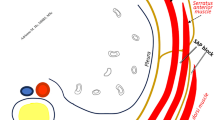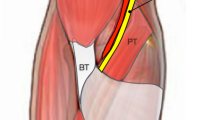Abstract
Improvements in pain management techniques in the last decade have had a major impact on the practice of total hip and knee arthroplasty (THA and TKA). Although there are a number of treatment options for postoperative pain, a gold standard has not been established. However, there appears to be a shift towards multimodal approaches using regional anesthesia to minimize narcotic consumption and to avoid narcotic-related side effects. Over the last 10 years, we have used intravenous patient-controlled analgesia (PCA), femoral nerve block (FNB), and continuous epidural infusions for 24 and 48 hours with and without FNB. Unfortunately, all of these techniques had shortcomings, not the least of which was suboptimal pain control and unwanted side effects. Our practice has currently evolved to using a multimodal protocol that emphasizes local periarticular injections while minimizing the use of parenteral narcotics. Multimodal protocols after THA and TKA have been a substantial advance; they provide better pain control and patient satisfaction, lower overall narcotic consumption, reduce hospital stay, and improve function while minimizing complications. Although no pain protocol is ideal, it is clear that patients should have optimum pain control after TKA and THA for enhanced satisfaction and function.
Level of Evidence: Level V, expert opinion. See the Guidelines for Authors for a complete description of levels of evidence.
Similar content being viewed by others
References
Barrington MJ, Olive D, Low K, Scott DA, Brittain J, Choong P. Continuous femoral nerve blockade or epidural analgesia after total knee replacement: a prospective randomized controlled trial. Anesth Analg. 2005;101:1824–1829.
Block BM, Liu SS, Rowlingson AJ, Cowan AR, Cowan JA Jr, Wu CL. Efficacy of postoperative epidural analgesia: a meta-analysis. JAMA. 2003;290:2455–2463.
Chelly JE, Greger J, Gebhard R, Coupe K, Clyburn TA, Buckle R, Criswell A. Continuous femoral blocks improve recovery and outcome of patients undergoing total knee arthroplasty. J Arthroplasty. 2001;16:436–445.
Choi PT, Bhandari M, Scott J, Douketis J. Epidural analgesia for pain relief following hip or knee replacement. Cochrane Database Syst Rev. 2003;3:CD003071.
Ekman EF, Koman LA. Acute pain following musculoskeletal injuries and orthopaedic surgery: mechanisms and management. Instr Course Lect. 2005;54:21–33.
Filos KS, Lehmann KA. Current concepts and practice in postoperative pain management: need for a change? Eur Surg Res. 1999;31:97–107.
Fischer HB, Simanski CJ. A procedure-specific systematic review and consensus recommendations for analgesia after total hip replacement. Anaesthesia. 2005;60:1189–1202.
Follin SL, Charland SL. Acute pain management: operative or medical procedures and trauma. Ann Pharmacother. 1997;31:1068–7106.
Fortier J, Chung F, Su J. Unanticipated admission after ambulatory surgery—a prospective study. Can J Anaesth. 1998;45:612–619.
Giraudet-Le Quintrec JS, Coste J, Vastel L, Pacault V, Jeanne L, Lamas JP, Kerboull L, Fougeray M, Conseiller C, Kahan A, Courpied JP. Positive effect of patient education for hip surgery: a randomized trial. Clin Orthop Relat Res. 2003;414:112–120.
Horlocker TT, Kopp SL, Pagnano MW, Hebl JR. Analgesia for total hip and knee arthroplasty: a multimodal pathway featuring peripheral nerve block. J Am Acad Orthop Surg. 2006;14:126–135.
Illgen RL, Pellino TA, Gordon DB, Butts S, Heiner JP. Prospective analysis of a novel long-acting oral opioid analgesic regimen for pain control after total hip and knee arthroplasty. J Arthroplasty. 2006;21:814–820.
Indelli PF, Grant SA, Nielsen K, Vail TP. Regional anesthesia in hip surgery. Clin Orthop Relat Res. 2005;441:250–255.
International Association for the Study of Pain (IASP) Task Force on Taxonomy Part III. Pain Terms. A Current List with Definitions and Notes on Usage. In: Merskey H, Bogduk N, eds. Classification of Chronic Pain, 2nd ed. Seattle, WA: IASP Press; 1994:209–214. [Available at http://www.iasp-pain.org. Accessed June 23, 2008].
Joint Commission on Accreditation of Healthcare Organizations. Pain Standards for 2001. Oakbook Terrace, IL: JCAHO; 2000.
Joshi GP. Multimodal analgesia techniques for ambulatory surgery. Int Anesthesiol Clin. 2005;43:197–204.
Lieberman JR, Huo MM, Hanway J, Salvati EA, Sculco TP, Sharrock NE. The prevalence of deep venous thrombosis after total hip arthroplasty with hypotensive epidural anesthesia. J Bone Joint Surg Am. 1994;76:341–348.
Lombardi AV Jr, Berend KR, Mallory TH, Dodds KL, Adams JB. Soft tissue and intra-articular injection of bupivacaine, epinephrine, and morphine has a beneficial effect after total knee arthroplasty. Clin Orthop Relat Res. 2004;428:125–130.
Maheshwari AV, Boutary M, Yun AG, Sirianni LE, Dorr LD. Multimodal analgesia without routine parenteral narcotics for total hip arthroplasty. Clin Orthop Relat Res. 2006;453:231–238.
McGregor AH, Rylands H, Owen A, Doré CJ, Hughes SP. Does preoperative hip rehabilitation advice improve recovery and patient satisfaction? J Arthroplasty. 2004;19:464–468.
Morin AM, Kratz CD, Eberhart LH, Dinges G, Heider E, Schwarz N, Eisenhardt G, Geldner G, Wulf H. Postoperative analgesia and functional recovery after total-knee replacement: comparison of a continuous posterior lumbar plexus (psoas compartment) block, a continuous femoral nerve block, and the combination of a continuous femoral and sciatic nerve block. Reg Anesth Pain Med. 2005;30:434–445.
Parvataneni HK, Ranawat AS, Ranawat CS. The use of local periarticular injections in the management of postoperative pain after total hip and knee replacement: a multimodal approach. Instr Course Lect. 2007;56:125–131.
Parvataneni HK, Shah VP, Howard H, Cole N, Ranawat AS, Ranawat CS. Controlling pain after total hip and knee arthroplasty using a multimodal protocol with local periarticular injections: a prospective randomized study. J Arthroplasty. 2007;22(6 Suppl 2):33–38.
Peters CL, Shirley B, Erickson J. The effect of a new multimodal perioperative anesthetic regimen on postoperative pain, side effects, rehabilitation, and length of hospital stay after total joint arthroplasty. J Arthroplasty. 2006;21(6 Suppl 2):132–138.
Phillips WJ, Currier BL. Analgesic pharmacology: I. Neurophysiology. J Am Acad Orthop Surg. 2004;12:213–220.
Ranawat AS, Ranawat CS. Pain management and accelerated rehabilitation for total hip and total knee arthroplasty. J Arthroplasty. 2007;22(7 Suppl 3):12–15.
Ranawat CS, Ranawat AS, Mehta A. Total knee arthroplasty rehabilitation protocol: what makes the difference? J Arthroplasty. 2003;18(3 Suppl 1):27–30.
Sharrock NE, Haas SB, Hargett MJ, Urquhart B, Insall JN, Scuderi G. Effects of epidural anesthesia on the incidence of deep-vein thrombosis after total knee arthroplasty. J Bone Joint Surg Am. 1991;73:502–506.
Sinatra RS, Torres J, Bustos AM. Pain management after major orthopaedic surgery: current strategies and new concepts. J Am Acad Orthop Surg. 2002;10:117–129.
Singelyn FJ, Deyaert M, Joris D, Pendeville E, Gouverneur JM. Effects of intravenous patient-controlled analgesia with morphine, continuous epidural analgesia, and continuous three-in-one block on postoperative pain and knee rehabilitation after unilateral total knee arthroplasty. Anesth Analg. 1998;87:88–92.
Singelyn FJ, Ferrant T, Malisse MF, Joris D. Effects of intravenous patient-controlled analgesia with morphine, continuous epidural analgesia, and continuous femoral nerve sheath block on rehabilitation after unilateral total-hip arthroplasty. Reg Anesth Pain Med. 2005;30:452–457.
Skinner HB, Shintani EY. Results of a multimodal analgesic trial involving patients with total hip or total knee arthroplasty. Am J Orthop. 2004;33:85–92.
Stein C. Peripheral mechanisms of opioid analgesia. Anesth Analg. 1993;76:182–191.
Vendittoli PA, Makinen P, Drolet P, Lavigne M, Fallaha M, Guertin MC, Varin F. A multimodal analgesia protocol for total knee arthroplasty. A randomized, controlled study. J Bone Joint Surg Am. 2006;88:282–289.
Viscusi ER, Martin G, Hartrick CT, Singla N, Manvelian G, EREM Study Group. Forty-eight hours of postoperative pain relief after total hip arthroplasty with a novel, extended-release epidural morphine formulation. Anesthesiology. 2005;102:1014–1022.
Westrich GH, Farrell C, Bono JV, Ranawat CS, Salvati EA, Sculco TP. The incidence of venous thromboembolism after total hip arthroplasty: a specific hypotensive epidural anesthesia protocol. J Arthroplasty. 1999;14:456–463.
Wheeler M, Oderda GM, Ashburn MA, Lipman AG. Adverse events associated with postoperative opioid analgesia: a systematic review. J Pain. 2002;3:159–180.
Author information
Authors and Affiliations
Corresponding author
Additional information
No funding was received for this manuscript. However, the research foundation of one or more of the authors (ASR, CSR) has received funding from DePuy Orthopaedics (Warsaw, IN) and Stryker Orthopaedics (Mahwah, NJ). One or more of the authors (ASR, CSR) has received royalties from DePuy Orthopaedics (Warsaw, IN) and Stryker Orthopaedics (Mahwah, NJ). ASR is a consultant for DePuy Orthopaedics (Warsaw, IN) and Stryker Orthopaedics (Mahwah, NJ). CSR is designer/consultant for DePuy Orthopaedics (Warsaw, IN) and Stryker Orthopaedics (Mahwah, NJ).
Each author certifies that his institution has approved the human protocol for this investigation and that all investigations were conducted in conformity with ethical principles of research, and that informed consent for participation in the study was obtained.
About this article
Cite this article
Maheshwari, A.V., Blum, Y.C., Shekhar, L. et al. Multimodal Pain Management after Total Hip and Knee Arthroplasty at the Ranawat Orthopaedic Center. Clin Orthop Relat Res 467, 1418–1423 (2009). https://doi.org/10.1007/s11999-009-0728-7
Received:
Accepted:
Published:
Issue Date:
DOI: https://doi.org/10.1007/s11999-009-0728-7




